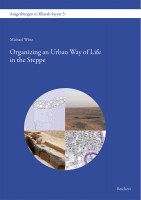Search
Organizing an Urban Way of Life in the Steppe
Water, Agriculture, Townscape and Economy in the Early Islamic Town of Kharab Sayyar
2019
21.0 x 29.7 cm, 448 p., 643 illustrations b/w, 109 Tafeln, hardback
ISBN: 9783954902743
21.0 x 29.7 cm, 448 p., 643 illustrations b/w, 109 Tafeln, hardback
148,00 €
ISBN: 9783954902743
Short Description
Organizing an Urban Way of Life in the Steppe – Water, Agriculture, Townscape and Economy in the Early Islamic Town of Kharab Sayyar.As the third volume in this series, “Organizing an Urban Way of Life in the Steppe” is looking to explore infrastructure, townscape and morphology of the settlement in a peripheral steppe area during early-islamic times. The work is based on more than ten years of archaeological fieldwork and explores the archaeology, geography, hydrology and history to reconstruct environment the town needed to exist. It will display how a provincial centre, in a peripheral area, was planned and built, how it functioned, how it evolved and finally was abandoned during early Islamic times. It also includes questions concerning site choice and economy or other agents of growth.
A large part of the work is concerned with the natural surroundings and the most important prerequisite and integral piece of infrastructure – water. Water was and is the most valuable source in the region – a substantial motor for agricultural economies and technological and architectural achievements. The built environment and the urban form will be explored by mapping geophysics and matching those against archaeological results obtained during more than 10 field-seasons. The report on the largest feature, the fortification, is included in this volume.
While likely founded earlier, Kharab Sayyar flourished during the Abbasid Era. Located in the steppe between Habur and Balikh it was surrounded by arable land and numerous smaller settlements. It was a waypoint, trading station, local market and administrative centre for this rural region – with a strong cultural link to the centres in the east. Let up in the tenth century AD it was not inhabited by settlers again until the 20th century – today the modern village and the ruins share the name.
Description
Organizing an Urban Way of Life in the Steppe – Water, Agriculture, Townscape and Economy in the Early Islamic Town of Kharab Sayyar.As the third volume in this series, “Organizing an Urban Way of Life in the Steppe” is looking to explore infrastructure, townscape and morphology of the settlement in a peripheral steppe area during early-islamic times. The work is based on more than ten years of archaeological fieldwork and explores the archaeology, geography, hydrology and history to reconstruct environment the town needed to exist. It will display how a provincial centre, in a peripheral area, was planned and built, how it functioned, how it evolved and finally was abandoned during early Islamic times. It also includes questions concerning site choice and economy or other agents of growth.
A large part of the work is concerned with the natural surroundings and the most important prerequisite and integral piece of infrastructure – water. Water was and is the most valuable source in the region – a substantial motor for agricultural economies and technological and architectural achievements. The built environment and the urban form will be explored by mapping geophysics and matching those against archaeological results obtained during more than 10 field-seasons. The report on the largest feature, the fortification, is included in this volume.
While likely founded earlier, Kharab Sayyar flourished during the Abbasid Era. Located in the steppe between Habur and Balikh it was surrounded by arable land and numerous smaller settlements. It was a waypoint, trading station, local market and administrative centre for this rural region – with a strong cultural link to the centres in the east. Let up in the tenth century AD it was not inhabited by settlers again until the 20th century – today the modern village and the ruins share the name.




 Preface
Preface

 Neuerscheinungen 2023/2024
Neuerscheinungen 2023/2024
 Gesamtverzeichnis 2023/2024
Gesamtverzeichnis 2023/2024
 Katalog Oriental Studies & Linguistics
Katalog Oriental Studies & Linguistics
 Mittelalter
Mittelalter
 Deutsche Inschriften
Deutsche Inschriften
 Musiktherapie
Musiktherapie
 Literaturen im Kontext
Literaturen im Kontext